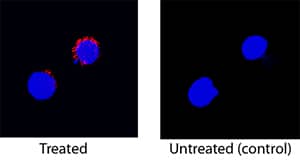Rat IFN-gamma Antibody
R&D Systems, part of Bio-Techne | Catalog # MAB5851

Key Product Details
Validated by
Biological Validation
Species Reactivity
Validated:
Rat
Cited:
Rat
Applications
Validated:
ELISA Capture (Matched Antibody Pair), Immunocytochemistry
Cited:
ELISA Development, Western Blot
Label
Unconjugated
Antibody Source
Monoclonal Mouse IgG1 Clone # 88928
Product Specifications
Immunogen
E. coli-derived recombinant rat IFN-gamma
Gln23-Cys156
Accession # P01581
Gln23-Cys156
Accession # P01581
Specificity
Detects rat IFN-gamma in ELISAs. In sandwich ELISAs, observed cross-reactivities were less than 2% with recombinant mouse IFN‑ gamma and less than 0.1% with recombinant human IFN‑ gamma and recombinant porcine IFN‑ gamma.
Clonality
Monoclonal
Host
Mouse
Isotype
IgG1
Scientific Data Images for Rat IFN-gamma Antibody
IFN‑ gamma in Rat Splenocytes.
IFN-gamma was detected in immersion fixed rat splenocytes treated with PMA and calcium ionomycin using Mouse Anti-Rat IFN-gamma Monoclonal Antibody (Catalog # MAB5851) at 25 µg/mL for 3 hours at room temperature. Cells were stained using the NorthernLights™ 557-conjugated Anti-Mouse IgG Secondary Antibody (red; Catalog # NL007) and counterstained with DAPI (blue). Specific staining was localized to cytoplasm. View our protocol for Fluorescent ICC Staining of Non-adherent Cells.Applications for Rat IFN-gamma Antibody
Application
Recommended Usage
Immunocytochemistry
8-25 µg/mL
Sample: Immersion fixed rat splenocytes treated with PMA and calcium ionomycin
Sample: Immersion fixed rat splenocytes treated with PMA and calcium ionomycin
Rat IFN-gamma Sandwich Immunoassay
Please Note: Optimal dilutions of this antibody should be experimentally determined.
Formulation, Preparation, and Storage
Purification
Protein A or G purified from hybridoma culture supernatant
Reconstitution
Reconstitute at 0.5 mg/mL in sterile PBS. For liquid material, refer to CoA for concentration.
Formulation
Lyophilized from a 0.2 μm filtered solution in PBS with Trehalose. *Small pack size (SP) is supplied either lyophilized or as a 0.2 µm filtered solution in PBS.
Shipping
Lyophilized product is shipped at ambient temperature. Liquid small pack size (-SP) is shipped with polar packs. Upon receipt, store immediately at the temperature recommended below.
Stability & Storage
Use a manual defrost freezer and avoid repeated freeze-thaw cycles.
- 12 months from date of receipt, -20 to -70 °C as supplied.
- 1 month, 2 to 8 °C under sterile conditions after reconstitution.
- 6 months, -20 to -70 °C under sterile conditions after reconstitution.
Background: IFN-gamma
References
- Billiau, A. and P. Matthys (2009) Cytokine Growth Factor Rev. 20:97.
- Pestka, S. et al. (2004) Immunol. Rev. 202:8.
- Dijkema, R. et al. (1985) EMBO J. 4:761.
- Marsters, S.A. et al. (1995) Proc. Natl. Acad. Sci. 92:5401.
- Krause, C.D. et al. (2000) J. Biol. Chem. 275:22995.
- Schroder, K. et al. (2004) J. Leukoc. Biol. 75:163.
- McLaren, J.E. and D.P. Ramji (2009) Cytokine Growth Factor Rev. 20:125.
- Muhl, H. and J. Pfeilschifter (2003) Int. Immunopharmacol. 3:1247.
- Kelchtermans, H. et al. (2008) Trends Immunol. 29:479.
Long Name
Interferon gamma
Alternate Names
IFG, IFI, IFNG, IFNgamma
Entrez Gene IDs
Gene Symbol
IFNG
UniProt
Additional IFN-gamma Products
Product Documents for Rat IFN-gamma Antibody
Product Specific Notices for Rat IFN-gamma Antibody
For research use only
